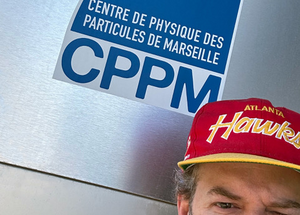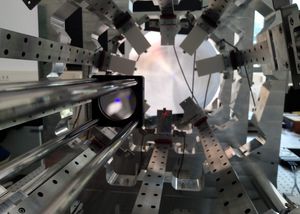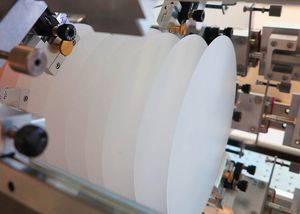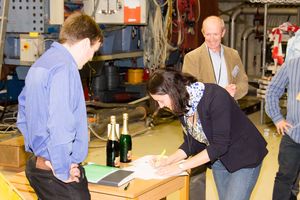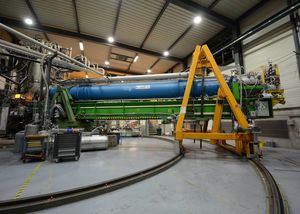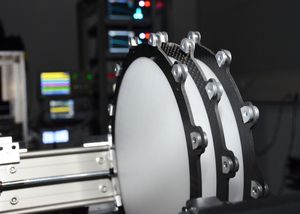The MADMAX experiment: searching for axion dark matter
The axion is one of the few hypothetical particles that can solve two major problems in physics: “What is the nature of dark matter?” and “why the strong interaction is invariant under time reversal?” (the strong CP problem). Scientists working on the recently initiated MADMAX (Magnetized Disc and Mirror Axion Experiment) project are looking for this fascinating new particle.
Axions would be unlike any of the known particles: cosmological models suggest that the axion’s mass would be between one microelectronvolt and one millielectronvolt, much lighter than even neutrinos, the lightest of known massive particles.
MADMAX would take advantage of the quantum mechanical mixing of particles — the ability of certain particles to take on the properties of other particles. In a static magnetic field, an axion behaves a little bit like a photon, developing a small electric field. The stronger the magnetic field, the more “photon-like” the axion becomes. If we could detect this electric field, we could verify the existence of dark matter axions.
Dielectric media in a strong magnetic field
Pivotal to detecting this electric field is the effect a change in dielectric media has on the axion. Dielectrics are simply non-conducting substances, like air, sapphire or plastic, though this also occurs in a mirror. The axion’s tiny electric field is broken at the boundary between the two media, resulting in electromagnetic radiation (microwaves) being emitted.
These electromagnetic waves are emitted at right angles from surface of the interface, allowing one to measure them by focusing the radiation into a detector. As the frequency of the radiation is given by the mass of the axion, cosmological considerations suggest that it could lie between 0.25 and 250 gigahertz. Unfortunately, even a sharp change in interface (as given by a one square meter mirror) inside a very powerful 10 Tesla magnetic field is not enough to see axions. The signal would only be a paltry 10-27 watts, beyond detectibility even with the most sensitive detectors.
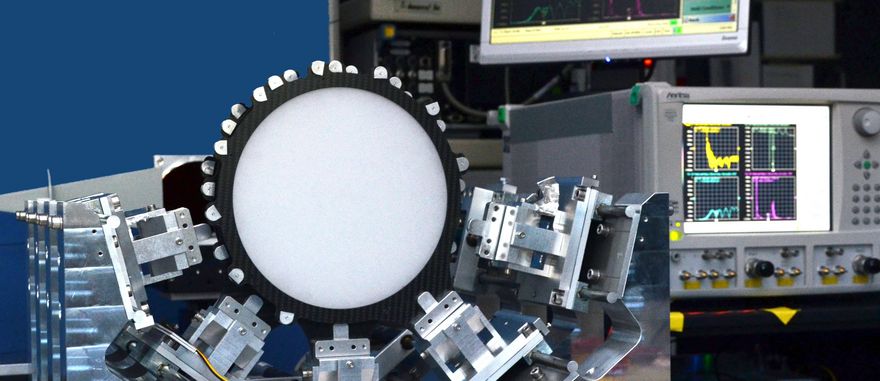
Boosting the signal: dielectric haloscopes
To search for axions, we must have some way of boosting the signal. Fortunately, this conversion of axions to microwave radiation would happen at any change of media.
By having many dielectric disks, one can combine the electromagnetic waves generated at multiple interfaces. In addition, reflections between the disks can cause resonance effects, further amplifying the signal. By carefully positioning the disks, one can use these effects coherently to amplify the conversion of axions to photons in a specific frequency range, and thus search a range of axion masses. Such a device is called a “dielectric haloscope”.
This is the plan of the MADMAX experiment: to boost the signal by using 80 dielectric disks in addition to the mirror, each with an area of one square meter and a high refractive index. The disks have to be positioned with micrometer precision. This setup will be contained in a 10 Tesla magnetic field — by comparison a simple fridge magnet is only about 0.05 Tesla. Scientists plan to use radiometers to detect the microwaves.
By using this many disks, one could achieve a signal that is tens or hundreds of thousands times stronger than a single mirror. This would give a signal in the order of 10-23 watt, which can be detected with current detector technology.
Promising approaches
The underlying principle has already been tested in initial experimental setups. While lacking a magnet, these setups had up to five sapphire disks (20 centimeters in diameter). With this kind of setup, it was possible to create an interference effect with the necessary precision and size. A dummy signal in the order of 10-23 watt was detected in a week-long measurement.
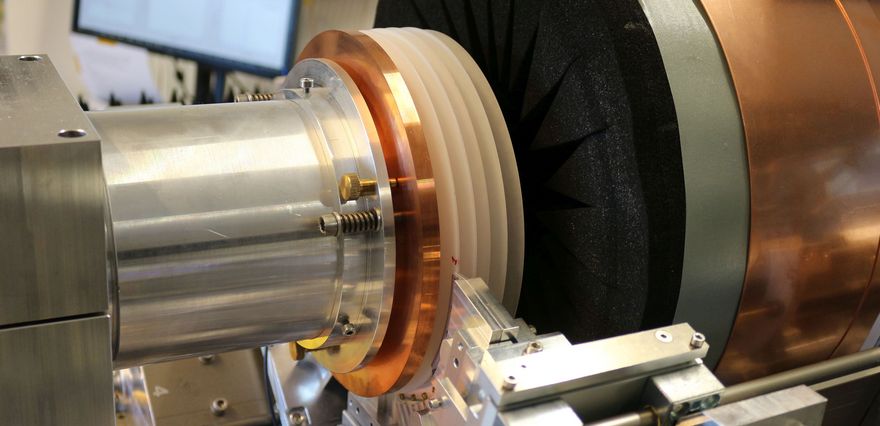
These results have been so promising that an interest group has formed to realise a dielectric haloscope in a full scale experiment. Groups from the following research institutions are currently participating in the project:
- Centre de Physique des Particules de Marseille (CPPM), France
- DESY Hamburg, Germany
- MPI for Physics, Munich, Germany
- MPI for Radio Astronomy, Bonn, Germany
- Néel Institute, Grenoble, France
- RWTH Aachen, Germany
- University of Hamburg, Germany
- University of Tübingen, Germany
- University of Zaragoza, Spain
The MPI is taking on the development of the radiometer in the 10 to 50 gigahertz frequency range, as well as the construction and characterisation of the disk system.
MADMAX at the MPP
Group members
E-mail address: e-mail@mpp.mpg.de
Phone number: +49 89 32354-extension
name
function
e-mail
extension
office
Benning, Maja
Student
maja.benning
327
A.2.69
Byun, HeeSu, Dr.
Postdoc
heesu.byun
327
A.2.69
Caldwell, Allen, Prof. Dr.
Director
allen.caldwell
529
A.2.51
Dvali, Gia, Prof. Dr.
Director
gia.dvali
306
A.3.41
Döbrich, Babette, Dr.
Senior Scientist
babette.doebrich
205
A.3.95
Fernando, Umashi
Student
umashi.fernando
380
A.2.67
Gooch, Christopher
Engineering
christopher.gooch
242
A.1.63
Ivanov, Anton, Dr.
Postdoc
anton.ivanov
509
A.2.77
Kittlinger, David
Engineering
david.kittlinger
345
B.2.FL2
Kreikemeyer, Dagmar, Dr.
Postdoc
dagmar.kreikemeyer
337
A.2.73
Lim, Elizabeth Mei Ying
Student
mei.lim
557
A.2.53
Liu, Xiang, Ph.D.
Senior Scientist
xiang.liu
415
A.1.65
Majorovits, Béla, PD Dr.
Senior Scientist
bela.majorovits
262
A.2.71
Maldonado, Juan
PhD Student
juan.maldonado
464
A.2.75
Obermüller, Georg
Engineering
georg.obermueller
394
B.2.35
Raffelt, Georg, Dr.
Senior Scientist
georg.raffelt
234
A.3.32
Sedlak, Alexander
Engineering
alexander.sedlak
768
B.2.35
Steffen, Frank Daniel, Dr.
Senior Scientist
frank.steffen
335
A.3.91
Wacker, Ina
Secretary
ina.wacker
207
A.2.49
Zaitseva, Eugenie
Student
eugenie.zaitseva
337
A.2.73
Group members
Phone number: +49 89 32354-extension
| name | function | extension | office | |
|---|---|---|---|---|
| Benning, Maja | Student | maja.benning | 327 | A.2.69 |
| Byun, HeeSu, Dr. | Postdoc | heesu.byun | 327 | A.2.69 |
| Caldwell, Allen, Prof. Dr. | Director | allen.caldwell | 529 | A.2.51 |
| Dvali, Gia, Prof. Dr. | Director | gia.dvali | 306 | A.3.41 |
| Döbrich, Babette, Dr. | Senior Scientist | babette.doebrich | 205 | A.3.95 |
| Fernando, Umashi | Student | umashi.fernando | 380 | A.2.67 |
| Gooch, Christopher | Engineering | christopher.gooch | 242 | A.1.63 |
| Ivanov, Anton, Dr. | Postdoc | anton.ivanov | 509 | A.2.77 |
| Kittlinger, David | Engineering | david.kittlinger | 345 | B.2.FL2 |
| Kreikemeyer, Dagmar, Dr. | Postdoc | dagmar.kreikemeyer | 337 | A.2.73 |
| Lim, Elizabeth Mei Ying | Student | mei.lim | 557 | A.2.53 |
| Liu, Xiang, Ph.D. | Senior Scientist | xiang.liu | 415 | A.1.65 |
| Majorovits, Béla, PD Dr. | Senior Scientist | bela.majorovits | 262 | A.2.71 |
| Maldonado, Juan | PhD Student | juan.maldonado | 464 | A.2.75 |
| Obermüller, Georg | Engineering | georg.obermueller | 394 | B.2.35 |
| Raffelt, Georg, Dr. | Senior Scientist | georg.raffelt | 234 | A.3.32 |
| Sedlak, Alexander | Engineering | alexander.sedlak | 768 | B.2.35 |
| Steffen, Frank Daniel, Dr. | Senior Scientist | frank.steffen | 335 | A.3.91 |
| Wacker, Ina | Secretary | ina.wacker | 207 | A.2.49 |
| Zaitseva, Eugenie | Student | eugenie.zaitseva | 337 | A.2.73 |
Key publications
A new experimenal approach to probe QCD axion dark matter in the mass range above 40 μeV
The MADMAX Collaboration
arXiv:1901.07401
accepted for publication by The European Physical Journal C (EPJ C)
Dielectric Haloscopes: A New Way to Detect Axion Dark Matter
The MADMAX Working Group: Allen Caldwell, Gia Dvali, Bela Majorovits, Alexander Millar, Georg Raffelt, Javier Redondo, Olaf Reimann, Frank Simon, Frank Steffen
Phys. Rev. Lett. 118, 091801 (2017)
arXiv:1611.05865
Dielectric Haloscopes to Search for Axion Dark Matter: Theoretical Foundations
Alexander J. Millar, Georg G. Raffelt, Javier Redondo, Frank D. Steffen
JCAP, 061 (2017)
arXiv:1612.07057
MADMAX: A new Dark Matter Axion Search using a Dielectric Haloscope
Béla Majorovits, Javier Redondo for the MADMAX Working Group (A. Caldwell, G. Dvali, C. Gooch, Contributed to the 12th Patras Workshop on Axions, WIMPs and WISPs, Jeju Island, South Korea, June 20 to 26, 2016
arXiv:1611.04549
From Resonant to Broadband Searches for WISPy Cold Dark MatterJoerg Jaeckel, Javier RedondoPhys. Rev. D 88, 115002 (2013) arXiv:1308.1103
Key publications
A new experimenal approach to probe QCD axion dark matter in the mass range above 40 μeV
The MADMAX Collaboration
arXiv:1901.07401
accepted for publication by The European Physical Journal C (EPJ C)
Dielectric Haloscopes: A New Way to Detect Axion Dark Matter
The MADMAX Working Group: Allen Caldwell, Gia Dvali, Bela Majorovits, Alexander Millar, Georg Raffelt, Javier Redondo, Olaf Reimann, Frank Simon, Frank Steffen
Phys. Rev. Lett. 118, 091801 (2017)
arXiv:1611.05865
Dielectric Haloscopes to Search for Axion Dark Matter: Theoretical Foundations
Alexander J. Millar, Georg G. Raffelt, Javier Redondo, Frank D. Steffen
JCAP, 061 (2017)
arXiv:1612.07057
MADMAX: A new Dark Matter Axion Search using a Dielectric Haloscope
Béla Majorovits, Javier Redondo for the MADMAX Working Group (A. Caldwell, G. Dvali, C. Gooch, Contributed to the 12th Patras Workshop on Axions, WIMPs and WISPs, Jeju Island, South Korea, June 20 to 26, 2016
arXiv:1611.04549
From Resonant to Broadband Searches for WISPy Cold Dark MatterJoerg Jaeckel, Javier RedondoPhys. Rev. D 88, 115002 (2013) arXiv:1308.1103

